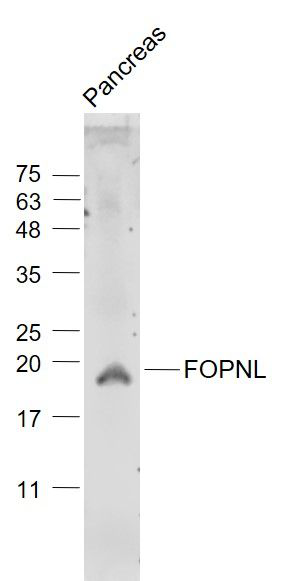产品货号 : mlR13197
英文名称 : FOPNL
中文名称 : 胚胎干细胞相关蛋白FOPNL抗体
别 名 : C16orf63; FGFR1OP N terminal like; FGFR1OP N-terminal-like protein; FOP-related protein of 20 kDa; Fopnl; FOPNL_HUMAN; FOR20; LisH domain containing protein C16orf63; LisH domain-containing protein FOPNL; PHSECRG2; Pluripotent embryonic stem cell related protein.
研究领域 : 肿瘤 免疫学 发育生物学 神经生物学 干细胞 细胞类型标志物
抗体来源 : Rabbit
克隆类型 : Polyclonal
交叉反应 : Human, Mouse, Rat, Dog, Pig, Cow, Horse, Sheep,
产品应用 : WB=1:500-2000 ELISA=1:500-1000 IHC-P=1:400-800 IHC-F=1:400-800 ICC=1:100-500 IF=1:100-500 (石蜡切片需做抗原修复)
not yet tested in other applications.
optimal dilutions/concentrations should be determined by the end user.
分 子 量 : 20kDa
细胞定位 : 细胞浆
性 状 : Lyophilized or Liquid
浓 度 : 1mg/ml
免 疫 原 : KLH conjugated synthetic peptide derived from human FOPNL/C16orf63:6-80/174
亚 型 : IgG
纯化方法 : affinity purified by Protein A
储 存 液 : 0.01M TBS(pH7.4) with 1% BSA, 0.03% Proclin300 and 50% Glycerol.
保存条件 : Store at -20 °C for one year. Avoid repeated freeze/thaw cycles. The lyophilized antibody is stable at room temperature for at least one month and for greater than a year when kept at -20°C. When reconstituted in sterile pH 7.4 0.01M PBS or diluent of antibody the antibody is stable for at least two weeks at 2-4 °C.
PubMed : PubMed
产品介绍 : C16orf63, also known as FLJ31153 or DKFZp686N1651, is a 174 amino acid protein that contains one LisH domain. The gene that encodes C16orf63 maps to human chromosome 16. Chromosome 16 encodes over 900 genes in approximately 90 million base pairs, makes up nearly 3% of human cellular DNA and is associated with a variety of genetic disorders. The GAN gene is located on chromosome 16 and, with mutation, may lead to giant axonal neuropathy, a nervous system disorder characterized by increasing malfunction with growth. The rare disorder Rubinstein-Taybi syndrome is also associated with chromosome 16, though through the CREBBP gene which encodes a critical CREB binding protein. Signs of Rubinstein-Taybi include mental retardation and predisposition to tumor growth and white blood cell neoplasias. Crohn's disease is a gastrointestinal inflammatory condition associated with chromosome 16 through the NOD2 gene. An association with systemic lupus erythematosis and a number of other autoimmune disorders with the pericentromeric region of chromosome 16 has led to the identification of SLC5A11 as a potential autoimmune modifier. The C16orf63 gene product has been provisionally designated C16orf63 pending further characterization.
Function:
Involved in the biogenesis of cilia.
Subunit:
Homooligomer; probably required for localization to centrosomes.
Subcellular Location:
Cell projection; cilium. Cytoplasm; cytoskeleton; cilium basal body. Cytoplasm; cytoskeleton; centrosome. Cytoplasmic granule. Localizes to pericentriolar satellites, small (70-100 nm) cytoplasmic granules associated with the centrosome.
Tissue Specificity:
Widely expressed. Detected in brain, heart, kidney, liver, lung, skeletal muscle, placenta and intestine.
Similarity:
Belongs to the FGFR1OP family.
Contains 1 LisH domain.
SWISS:
Q96NB1
Gene ID:
123811
Important Note:
This product as supplied is intended for research use only, not for use in human, therapeutic or diagnostic applications.
产品图片












